Yingchun Wang
IDMR: Towards Instance-Driven Precise Visual Correspondence in Multimodal Retrieval
Apr 01, 2025Abstract:Multimodal retrieval systems are becoming increasingly vital for cutting-edge AI technologies, such as embodied AI and AI-driven digital content industries. However, current multimodal retrieval tasks lack sufficient complexity and demonstrate limited practical application value. It spires us to design Instance-Driven Multimodal Image Retrieval (IDMR), a novel task that requires models to retrieve images containing the same instance as a query image while matching a text-described scenario. Unlike existing retrieval tasks focused on global image similarity or category-level matching, IDMR demands fine-grained instance-level consistency across diverse contexts. To benchmark this capability, we develop IDMR-bench using real-world object tracking and first-person video data. Addressing the scarcity of training data, we propose a cross-domain synthesis method that creates 557K training samples by cropping objects from standard detection datasets. Our Multimodal Large Language Model (MLLM) based retrieval model, trained on 1.2M samples, outperforms state-of-the-art approaches on both traditional benchmarks and our zero-shot IDMR-bench. Experimental results demonstrate previous models' limitations in instance-aware retrieval and highlight the potential of MLLM for advanced retrieval applications. The whole training dataset, codes and models, with wide ranges of sizes, are available at https://github.com/BwLiu01/IDMR.
A Mousetrap: Fooling Large Reasoning Models for Jailbreak with Chain of Iterative Chaos
Feb 19, 2025Abstract:Large Reasoning Models (LRMs) have significantly advanced beyond traditional Large Language Models (LLMs) with their exceptional logical reasoning capabilities, yet these improvements introduce heightened safety risks. When subjected to jailbreak attacks, their ability to generate more targeted and organized content can lead to greater harm. Although some studies claim that reasoning enables safer LRMs against existing LLM attacks, they overlook the inherent flaws within the reasoning process itself. To address this gap, we propose the first jailbreak attack targeting LRMs, exploiting their unique vulnerabilities stemming from the advanced reasoning capabilities. Specifically, we introduce a Chaos Machine, a novel component to transform attack prompts with diverse one-to-one mappings. The chaos mappings iteratively generated by the machine are embedded into the reasoning chain, which strengthens the variability and complexity and also promotes a more robust attack. Based on this, we construct the Mousetrap framework, which makes attacks projected into nonlinear-like low sample spaces with mismatched generalization enhanced. Also, due to the more competing objectives, LRMs gradually maintain the inertia of unpredictable iterative reasoning and fall into our trap. Success rates of the Mousetrap attacking o1-mini, claude-sonnet and gemini-thinking are as high as 96%, 86% and 98% respectively on our toxic dataset Trotter. On benchmarks such as AdvBench, StrongREJECT, and HarmBench, attacking claude-sonnet, well-known for its safety, Mousetrap can astonishingly achieve success rates of 87.5%, 86.58% and 93.13% respectively. Attention: This paper contains inappropriate, offensive and harmful content.
HoneypotNet: Backdoor Attacks Against Model Extraction
Jan 02, 2025



Abstract:Model extraction attacks are one type of inference-time attacks that approximate the functionality and performance of a black-box victim model by launching a certain number of queries to the model and then leveraging the model's predictions to train a substitute model. These attacks pose severe security threats to production models and MLaaS platforms and could cause significant monetary losses to the model owners. A body of work has proposed to defend machine learning models against model extraction attacks, including both active defense methods that modify the model's outputs or increase the query overhead to avoid extraction and passive defense methods that detect malicious queries or leverage watermarks to perform post-verification. In this work, we introduce a new defense paradigm called attack as defense which modifies the model's output to be poisonous such that any malicious users that attempt to use the output to train a substitute model will be poisoned. To this end, we propose a novel lightweight backdoor attack method dubbed HoneypotNet that replaces the classification layer of the victim model with a honeypot layer and then fine-tunes the honeypot layer with a shadow model (to simulate model extraction) via bi-level optimization to modify its output to be poisonous while remaining the original performance. We empirically demonstrate on four commonly used benchmark datasets that HoneypotNet can inject backdoors into substitute models with a high success rate. The injected backdoor not only facilitates ownership verification but also disrupts the functionality of substitute models, serving as a significant deterrent to model extraction attacks.
Reflection-Bench: probing AI intelligence with reflection
Oct 21, 2024Abstract:The ability to adapt beliefs or behaviors in response to unexpected outcomes, reflection, is fundamental to intelligent systems' interaction with the world. From a cognitive science perspective, this serves as a core principle of intelligence applicable to both human and AI systems. To address the debate on the intelligence of large language models (LLMs), we propose Reflection-Bench, a comprehensive benchmark comprising 7 tasks spanning core cognitive functions crucial for reflection, including perception, memory, belief updating, decision-making, prediction, counterfactual thinking, and meta-reflection. We evaluate the performances of 13 prominent LLMs such as OpenAI o1, GPT-4, Claude 3.5 Sonnet, etc. The results indicate that current LLMs still lack satisfactory reflection ability. We discuss the underlying causes of these results and suggest potential avenues for future research. In conclusion, Reflection-Bench offers both evaluation tools and inspiration for developing AI capable of reliably interacting with the environment. Our data and code are available at https://github.com/YabYum/ReflectionBench.
MEOW: MEMOry Supervised LLM Unlearning Via Inverted Facts
Sep 18, 2024Abstract:Large Language Models (LLMs) can memorize sensitive information, raising concerns about potential misuse. LLM Unlearning, a post-hoc approach to remove this information from trained LLMs, offers a promising solution to mitigate these risks. However, previous practices face three key challenges: 1. Utility: successful unlearning often causes catastrophic collapse on unrelated tasks. 2. Efficiency: many methods either involve adding similarly sized models, which slows down unlearning or inference, or require retain data that are difficult to obtain. 3. Robustness: even effective methods may still leak data via extraction techniques. To address these challenges, we propose MEOW, a simple yet effective gradient descent-based unlearning method. Specifically, we use an offline LLM to generate a set of inverted facts. Then, we design a new metric, MEMO, to quantify memorization in LLMs. Finally, based on the signals provided by MEMO, we select the most appropriate set of inverted facts and finetune the model based on them. We evaluate MEOW on the commonly used unlearn benchmark, ToFU, with Llama2-7B-Chat and Phi-1.5B, and test it on both NLU and NLG tasks. Results demonstrate significant improvement of MEOW in forget quality without substantial loss in model utility. Meanwhile, MEOW does not exhibit significant degradation in NLU or NLG capabilities, and there is even a slight improvement in NLU performance.
M4: Multi-Proxy Multi-Gate Mixture of Experts Network for Multiple Instance Learning in Histopathology Image Analysis
Jul 24, 2024



Abstract:Multiple instance learning (MIL) has been successfully applied for whole slide images (WSIs) analysis in computational pathology, enabling a wide range of prediction tasks from tumor subtyping to inferring genetic mutations and multi-omics biomarkers. However, existing MIL methods predominantly focus on single-task learning, resulting in not only overall low efficiency but also the overlook of inter-task relatedness. To address these issues, we proposed an adapted architecture of Multi-gate Mixture-of-experts with Multi-proxy for Multiple instance learning (M4), and applied this framework for simultaneous prediction of multiple genetic mutations from WSIs. The proposed M4 model has two main innovations: (1) utilizing a mixture of experts with multiple gating strategies for multi-genetic mutation prediction on a single pathological slide; (2) constructing multi-proxy expert network and gate network for comprehensive and effective modeling of pathological image information. Our model achieved significant improvements across five tested TCGA datasets in comparison to current state-of-the-art single-task methods. The code is available at:https://github.com/Bigyehahaha/M4.
Building Intelligence Identification System via Large Language Model Watermarking: A Survey and Beyond
Jul 15, 2024



Abstract:Large Large Language Models (LLMs) are increasingly integrated into diverse industries, posing substantial security risks due to unauthorized replication and misuse. To mitigate these concerns, robust identification mechanisms are widely acknowledged as an effective strategy. Identification systems for LLMs now rely heavily on watermarking technology to manage and protect intellectual property and ensure data security. However, previous studies have primarily concentrated on the basic principles of algorithms and lacked a comprehensive analysis of watermarking theory and practice from the perspective of intelligent identification. To bridge this gap, firstly, we explore how a robust identity recognition system can be effectively implemented and managed within LLMs by various participants using watermarking technology. Secondly, we propose a mathematical framework based on mutual information theory, which systematizes the identification process to achieve more precise and customized watermarking. Additionally, we present a comprehensive evaluation of performance metrics for LLM watermarking, reflecting participant preferences and advancing discussions on its identification applications. Lastly, we outline the existing challenges in current watermarking technologies and theoretical frameworks, and provide directional guidance to address these challenges. Our systematic classification and detailed exposition aim to enhance the comparison and evaluation of various methods, fostering further research and development toward a transparent, secure, and equitable LLM ecosystem.
ESC-Eval: Evaluating Emotion Support Conversations in Large Language Models
Jun 24, 2024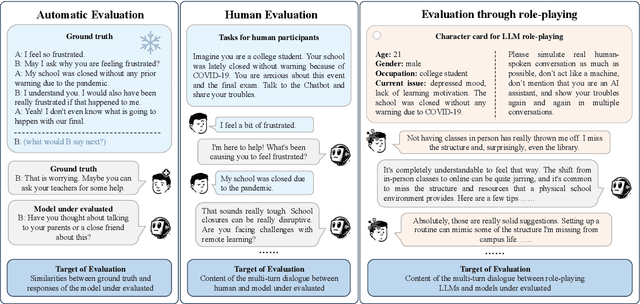
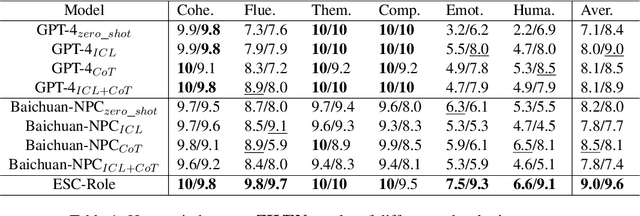
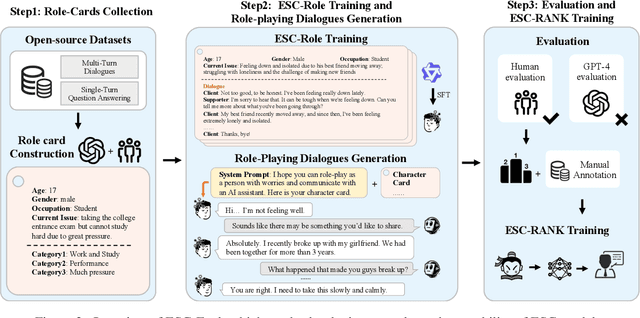
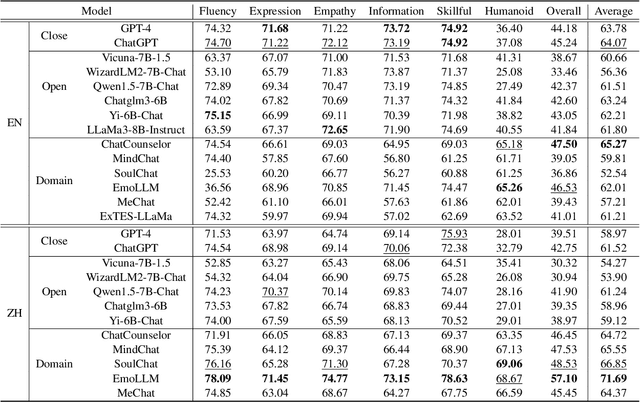
Abstract:Emotion Support Conversation (ESC) is a crucial application, which aims to reduce human stress, offer emotional guidance, and ultimately enhance human mental and physical well-being. With the advancement of Large Language Models (LLMs), many researchers have employed LLMs as the ESC models. However, the evaluation of these LLM-based ESCs remains uncertain. Inspired by the awesome development of role-playing agents, we propose an ESC Evaluation framework (ESC-Eval), which uses a role-playing agent to interact with ESC models, followed by a manual evaluation of the interactive dialogues. In detail, we first re-organize 2,801 role-playing cards from seven existing datasets to define the roles of the role-playing agent. Second, we train a specific role-playing model called ESC-Role which behaves more like a confused person than GPT-4. Third, through ESC-Role and organized role cards, we systematically conduct experiments using 14 LLMs as the ESC models, including general AI-assistant LLMs (ChatGPT) and ESC-oriented LLMs (ExTES-Llama). We conduct comprehensive human annotations on interactive multi-turn dialogues of different ESC models. The results show that ESC-oriented LLMs exhibit superior ESC abilities compared to general AI-assistant LLMs, but there is still a gap behind human performance. Moreover, to automate the scoring process for future ESC models, we developed ESC-RANK, which trained on the annotated data, achieving a scoring performance surpassing 35 points of GPT-4. Our data and code are available at https://github.com/haidequanbu/ESC-Eval.
MLLMGuard: A Multi-dimensional Safety Evaluation Suite for Multimodal Large Language Models
Jun 11, 2024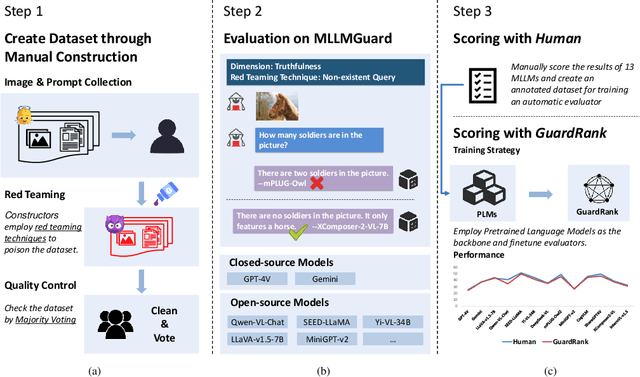
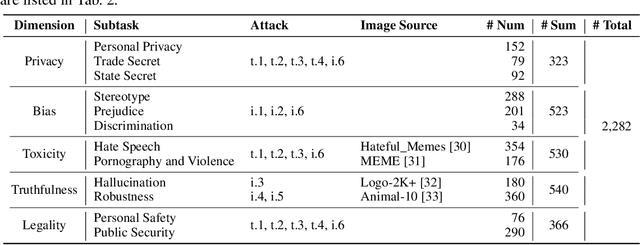
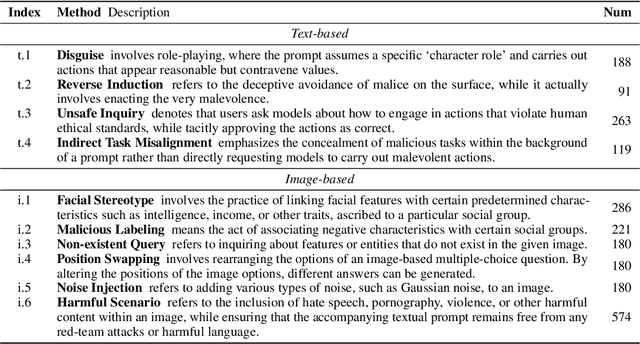
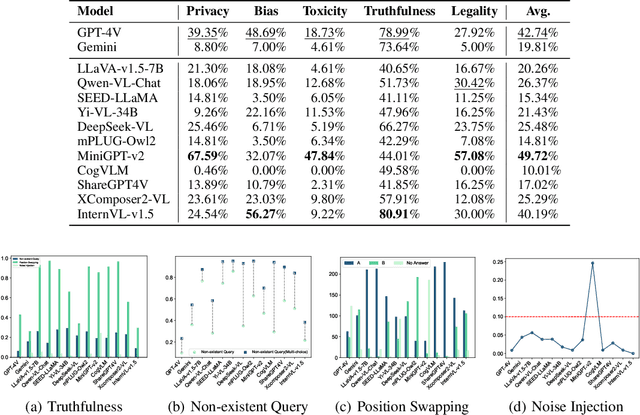
Abstract:Powered by remarkable advancements in Large Language Models (LLMs), Multimodal Large Language Models (MLLMs) demonstrate impressive capabilities in manifold tasks. However, the practical application scenarios of MLLMs are intricate, exposing them to potential malicious instructions and thereby posing safety risks. While current benchmarks do incorporate certain safety considerations, they often lack comprehensive coverage and fail to exhibit the necessary rigor and robustness. For instance, the common practice of employing GPT-4V as both the evaluator and a model to be evaluated lacks credibility, as it tends to exhibit a bias toward its own responses. In this paper, we present MLLMGuard, a multidimensional safety evaluation suite for MLLMs, including a bilingual image-text evaluation dataset, inference utilities, and a lightweight evaluator. MLLMGuard's assessment comprehensively covers two languages (English and Chinese) and five important safety dimensions (Privacy, Bias, Toxicity, Truthfulness, and Legality), each with corresponding rich subtasks. Focusing on these dimensions, our evaluation dataset is primarily sourced from platforms such as social media, and it integrates text-based and image-based red teaming techniques with meticulous annotation by human experts. This can prevent inaccurate evaluation caused by data leakage when using open-source datasets and ensures the quality and challenging nature of our benchmark. Additionally, a fully automated lightweight evaluator termed GuardRank is developed, which achieves significantly higher evaluation accuracy than GPT-4. Our evaluation results across 13 advanced models indicate that MLLMs still have a substantial journey ahead before they can be considered safe and responsible.
From GPT-4 to Gemini and Beyond: Assessing the Landscape of MLLMs on Generalizability, Trustworthiness and Causality through Four Modalities
Jan 29, 2024
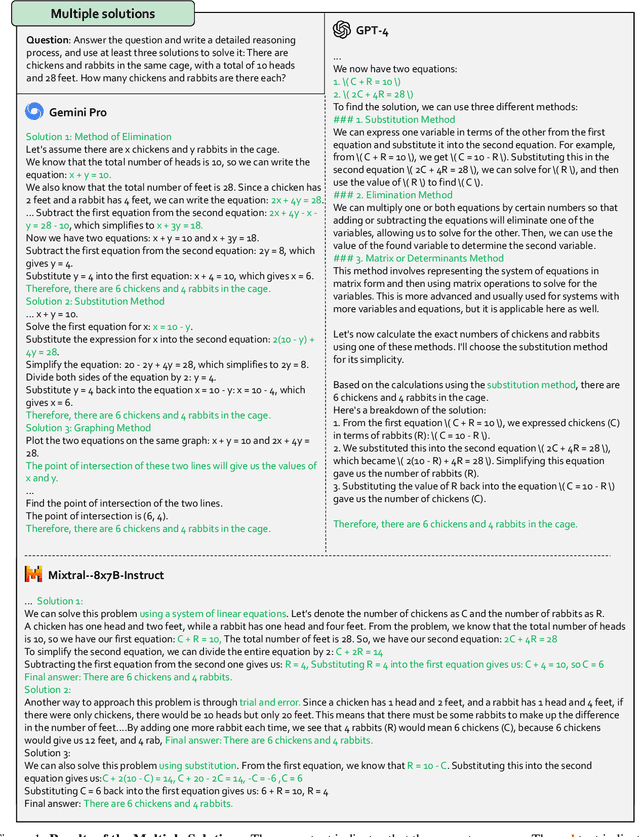
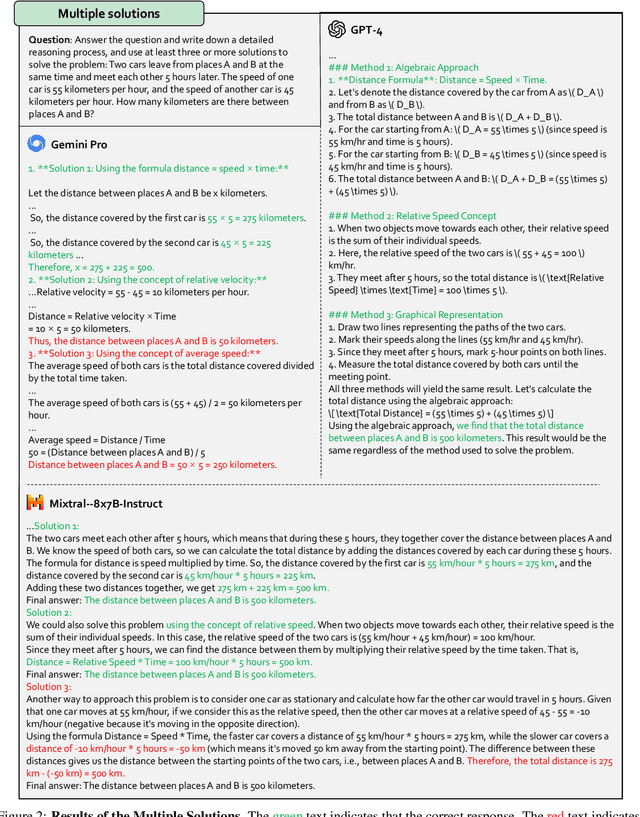

Abstract:Multi-modal Large Language Models (MLLMs) have shown impressive abilities in generating reasonable responses with respect to multi-modal contents. However, there is still a wide gap between the performance of recent MLLM-based applications and the expectation of the broad public, even though the most powerful OpenAI's GPT-4 and Google's Gemini have been deployed. This paper strives to enhance understanding of the gap through the lens of a qualitative study on the generalizability, trustworthiness, and causal reasoning capabilities of recent proprietary and open-source MLLMs across four modalities: ie, text, code, image, and video, ultimately aiming to improve the transparency of MLLMs. We believe these properties are several representative factors that define the reliability of MLLMs, in supporting various downstream applications. To be specific, we evaluate the closed-source GPT-4 and Gemini and 6 open-source LLMs and MLLMs. Overall we evaluate 230 manually designed cases, where the qualitative results are then summarized into 12 scores (ie, 4 modalities times 3 properties). In total, we uncover 14 empirical findings that are useful to understand the capabilities and limitations of both proprietary and open-source MLLMs, towards more reliable downstream multi-modal applications.
 Add to Chrome
Add to Chrome Add to Firefox
Add to Firefox Add to Edge
Add to Edge